
Sex
We Are Idea Addicts
She thought sex was a treatment modality for back pain.
Posted September 2, 2014
“What have I done?!” Tina exclaimed with her fists crushing her temples. (all identities protected)

“I let him back into my bedroom! OMG Dr. Johnson! I let him back in,” her fist-vice now opening fingers to rake hard back threw her wavy dark hair, pulling all two feet of it up and out like electrified witches hair.
“I know. I know. But it’s so hard. I thought I could stop but I just can’t sometimes.”
Her guilty green eyes flicked up across my face and quickly down again.
What’s a doctor to do?
“Just show calm, Vance.” I told myself, even as my facial muscles tightened just a touch. “Did she catch that?!”
I pushed the blood pressure cuff across the table just to do something with my hands. This woman makes me feel like kicking back and listening for an hour. She’s like a Scarlett Johansson but with unsettled distant eyes. How did she get this way? How does she survive?
“I bet Dana is watching the clock,” I thought. “She’s lucky we can’t see her face since she’s facing the monitor.” But I can see my assistant’s reflection and I’m sure she smirked at me.
Marie Calenders would move a lot more pie if Dana were at the front door. She knows about everyone’s interests and chats them up even as she gets the vital information to prep them in the exam room. They feel at home in a minute and ready for blind comfort.
“Maybe I should sell pies to help cover the overhead.” I wondered. “I’ll call them Obamacare pies made with sour cherries.”
Before I enter an exam room, Dana usually gives me her take on what’s going on with each case.
“This poor girl’s back pain is the least of her problems! She’s got a bad man and no self respect. Watch out Dr. J. She didn’t take your advice and you’re wasting your breath,” she lowered her chin to the left and looked up past her eyebrows at me, “and we’re going to fall behind before we even get to the fourth patient.” She is the Oprah Winfrey of medical assistants.
“I don’t tell him this but,” Tina says as she studies the dressing curtain pulled back against the wall, “it’s not all bad.” Her folded hands on her lap slide together out and back over her pre-faded jeans. “The pain goes away when we have sex.”
Reviewing my mental flash drive:
30 years old. Masters in Business Administration.
Back pain for two years.
No specific cause.
Random flare-ups.
Coincidentally her sex based abusive relationship with her boyfriend began two years ago as well.
Co-workers at a local winery make up most of her social support community since she moved to California.
She tried massage, acupuncture, chiropractic, and some kind of homeopathic drops under her tongue and behind her ears.
She knows all the treatments because she has had chronic pain of various body parts since 16 years old.
Tina had “a past” and she knew it was still “like, in my body.” Her boyfriend “you know, really feels good when he comes to me,” but then, “he’s gone. I mean, I tell him to go.”
“I got my work desk and chair changed out for a really ergonomic setup.” She committed to getting the boyfriend out of her life. She took my referral to a psychiatrist who specialized in treating women and said “yeah, I’ll check this out right away.”
I ordered an MRI and talked about treatment options.
The MRI got done. The psychiatrist consult did not.
“That’s something! Right?” Tina said with a timid lips curling up in at the edges in an attempted smile. “I know. I know. I’m going to stop letting him in. I’ll call that psychiatrist this time. Can you give me the number again?”
This is the point when I either ignore everything but her spine and stay on schedule or treat her like a whole person and fall behind. Insurance only pays for the former, not the later.

Slender and tragic as Shahrazad, Tina was a heartbreak waiting to happen. We weren’t going to get much success with her back pain until she got safe from abuse and gained self respect. This would take a thousand and one nights but I only had 20 minutes left.
“Tina, let’s look at your MRI then we’ll talk about what can be done.”
The MRI showed a 2 millimeter bulge of the 4th lumbar disc. “This is a common finding that can be found even in people with no symptoms.” I began.
Dana, knowing this speech, began preparing the paperwork for the referrals and my favorite lifestyle improvement education information.
“There can be several sources of back pain that overlap in how they are felt.” I continued.
“We can talk about them from the skin inward to the spinal canal. Skin, muscle, tendons, ligaments,” … blah, blah, blah. “What is this droning coming out of my mouth? She doesn’t care about the anatomy or physiology of spine.
“Then there is the experience of pain as coordinated by your spinal cord and brain that can happen with our without the other structures involved.”
“Suppose your life sucks,” Tina interrupted. Red rising in her cheeks. “A lot.”
“Your husband vanished and your boyfriend is a jerk.” Suddenly stonefaced, she uncrossed her legs and planted her running shoes 18 inches apart.
“And! My back hurts!”
Pain comes in so many forms that it almost defies definition. The part of the definition that everyone agrees on is that pain is unpleasant. The catch is that not all things unpleasant are painful.
Sometimes a pinch is a pain unless of course it’s by the right person in the right place.
All these thoughts and emotions were created by her three-pound loaf of flesh we call her brain. Is that where she feels the pain? Her self-loathing, regret, and anxiety were all carried by electrochemical signals converging in an almond-shaped sponge of tissue in her brain called the Amygdala.

Like gently helping a friend by cleaning the smudges they didn’t notice on the lenses of their glasses, I wanted to assist the calming response directed by her frontal cortex. Her memory of her pain and boyfriend was coordinated by a seahorse-shaped fold of neurons called the Hippocampus, which reactivated a web of links throughout her brain that first fired together years before and eventually hard-wired together.
What do I do with her? She’s not going to like me telling her that her spine is fine.
Should I try to help her gain insight or just write a script? How about pass the buck with, “You know, I’m a subspecialist who operates only the upper two lumbar discs. Let me refer you to my colleague.”
Primum non nocere. First do no harm. I didn’t forget, even though Tina said she wanted me to do SOMETHING, ANYTHING!

Part of the reason people come to me is to learn about what they should expect. I am to apply my years of study and experience to their personal situation and read their fortune. Setting expectations shrewdly can be more helpful than surgery or pills.
A study published in the scientific journal Nature Neuroscience this summer by Yves De Koninck and Robert Bonin, two researchers at Université Laval, reveals that it is possible to relieve pain hypersensitivity using a new method that involves rekindling pain so that it can subsequently be erased. It’s like the opposite of anticipating pain. It can be taught is a Cognitive Behavioral Therapy (CBT.)
The idea of pain can make us hurt. Tina had the idea and years of nurturing it instead of starving it. Denial can be the best medicine. Building new thought patterns can be even better. Tina found help with both but not enough. She and her support team did a total mind reset a few months later by ECT (Electroconvulsive therapy) and turbo charge her CBT workouts.
If the idea of pain can make us hurt, can the idea of joy make us happy?




